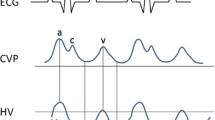Abstract
Aim-Background
The introduction of laparoscopic surgery has dramatically changed the management of gallstone disease, establishing laparoscopic cholecystectomy as the method of choice for treating cholelithiasis. The aim of this study is to review the significance of patient positioning and pneumoperitoneum in laparoscopic cholecystectomy as potential risk factors for the development of postoperative venous thromboembolism (VTE), with the use of impedance plethysmography (IPG).
Patients and Methods
We studied 40 consecutive patients undergoing selective laparoscopic cholecystectomy. Seventeen patients of our study group were positioned on the operating table in the lithotomy (French) position and 23 in the supine (American) position. Femoral venous capacitance (VC) and maximum venous outflow (MVO) from both legs of the patient was obtained using an impedance ple-thysmography (IPG) device. These parameters were measured: a) the day before operation, b) after French or American positioning on the surgical table, c) at the time of inflation to produce pneumoperitoneum, d) 30 minutes after pneumoperitoneum, and e) 24 hours after surgery.
Results
Our study confirms that the patient’s position on the surgical table (French or American position) does not affect venous haemodynamics of the legs. Peritoneal carbon dioxide insufflations to an intrabdominal pressure of 12 mm Hg produce haemodynamic changes, significantly increased after the beginning of peritoneal insufflations.VC and MVO were significantly increased during surgery in both positions. However, after exsufflation and at the first postoperative day, all haemodynamic parameters returned to preoperative values.
Conclusion
Our study advocates no difference between French or American positioning during laparoscopic cholecystectomy in measurements obtained from both legs of the patient using an impedance plethysmography device.
Similar content being viewed by others
References
Lindberg F, Bergqvist D, Rasmussen I (1997) Incidence of thromboembolic complications after laparoscopic cholecystectomy: Review of the literature. Surg Laparosc Endosc 7:324–331
Deziel DJ, Millikan KW, Economou SG, Doolas A, Sung TS, Airan MC (1993) Complications of Laparoscopic Cholecystectomy. A national survey of 4292 hospitals and an analysis of 77604 cases. Am J Surg 165: 9–14
Soper NJ, Brunt ML, Kerbl K (1994) Laparoscopic general surgery. N Engl J Med 330:409–419
Barnes GE, Laine GA, Giam PY, et al (1985) Cardiovascular response to elevation of intrabdominal hydrostatic pressure. Am J Physiol 248: R208–R213.
Goodale RL, Beebe DS, McNevin M, et al (1993) Hemodynamic, respiratory and metabolic effects of laparoscopic cholecystectomy. Am J Surg 166:533–537.
Schietroma M, Carlei F, Mownah A, Franchi L, Mazzotta C, Sozio A (2004) Changes in the blood coagulation, fibrinolysis, and cytokine profile during laparoscopic and open cholecystectomy. Surg Endosc. 18(7):1090–1096
Caprini JA, Arcelus JI, Laubach M, Size G, Hoffman KN (1995) Postoperative Hypercoagulability and Deep-Vein Thrombosis after Laparoscopic Cholecystectomy. Surg Endosc 9(3): 304–309.
Healey MG, Maher PJ, Hill DJ (1998) The Risk of Venous Thrombosis Following Gynecological Laparoscopic Surgery. Med J Aust, 168(10): 524
Sobolewski AP, Deshmukh RM, Brunson BL (1995) Venous hemodynamic changes during Laparoscopic Cholecystectomy. J Laparoendosc Surg. 5(6): 363–369
Gensini GF, Prisco D, Falciani M, Comeglio M, Colella A, (1997) Identification of Candidates for Prevention of Venous Thromboembolism. Semin Thromb Hemost 23(1): 55–67.
Cramer M, Langlois Y, Beach K, Martin D, Strandness DE Jr (1983) Standardization of venous flow measurement by strain gauge plethysmography in normal subjects. Bruit 7, 33–40.
NIH (1986) Consensus conference on prevention of venous thrombosis and pulmonary embolism. JAMA 256:744–748
Anderson FA Jr, Spencer FA (2003) Risk factors for venous thromboembolism. Circulation 107: I9–I16.
Anderson FA Jr, Wheeler HB, Goldberg RJ, Hosmer DW, Forcier A (1992) The prevalence of risk factors for venous thromboembolism among hospital patients. Arch Intern Med 152: 1660–664.
Gerotziafas GT, Samama MM (2004) Prophylaxis of venous thromboembolism in medical patients. Curr Opin Pulm Med. 10:356–365
Neudecker J, Sauerland S, Neugebauer E, et al (2002) The European Association for Endoscopic Surgery clinical practice guideline on the pneumoperitoneum for laparoscopic surgery. Surg Endosc 16: 1121–43.
Mall JW, Schwenk W, Rödiger O, Zippel K, Pollmann C, Müller JM. (2001) Blinded prospective study of the incidence of deep venous thrombosis following conventional or laparoscopic colorectal resection Br J Surg 88: 99–100.
Schaepkens Van Riempst JT, Van Hee RH, Weyler J (2002) Deep venous thrombosis after laparoscopic cholecystectomy and prevention with nadroparin. Surg Endosc 16: 184–187.
Geerts WH, Heit JA, Clagett GP, Pineo GF, Colwell CW, Anderson FA, Wheeler HB (2001) Prevention of venous thromboembolism. Chest 119: 132S–175S.
Collins R, Scrimgeour A, Yusuf S, Petro R (1988) Reduction in fatal pulmonary embolism and venous thrombosis by perioperative administration of subcutaneous heparin. N Engl J Med 318
Beekman R, Crowther M, Farrokhyar F, Birch D W (2006) Practice patterns for deep vein thrombosis prophylaxis in minimalaccess surgery. Canadian Journal of Surgery. Publication
Zacharoulis D, Kakkar A (2003) Venous thromboembolism in laparoscopic surgery. Current Opinion in Pulmonary Medicine. 9(5): 356–361
Catheline JM, Gaillard JL, Rizk N, Barrat C, Champault G (1998) Facteurs de risqué prevention du risqué thrombo-embolique en laparoscopie. Ann Chir 52: 890–895.
Lord RVN, Ling JJ, Hugh TB, Coleman MJ, Doust BD, Nivison-Smith I (1998) Incidence of deep vein thrombosis after laparoscopic vs minilaparotomy cholecystectomy.Arch Surg 133: 967–973.
Okuda Y, Kitajima T, Egawa H, Hamaguchi S, Yamaguchi S, Yamazaki H, Ido K(2002) A combination of heparin and an intermittent pneumatic compression device may be more effective to prevent deep-vein thrombosis in the lower extremities after laparoscopic cholecystectomy. Surg Endosc 16: 781–784.
Morris JR, Woodcock PJ. (2004) Evidence-Based Compression. Prevention of Stasis and Deep Vein Thrombosis. Ann Surg. 239(2): 162–171.
Author information
Authors and Affiliations
Corresponding author
Rights and permissions
About this article
Cite this article
Letsos, S., Diamantis, T., Legga, O. et al. Influence of patient positioning and pneumoperitoneum on lower limbs venous haemodynamics during laparoscopic cholecystectomy. Hellenic J Surg 85, 78–84 (2013). https://doi.org/10.1007/s13126-013-0014-8
Received:
Accepted:
Published:
Issue Date:
DOI: https://doi.org/10.1007/s13126-013-0014-8




